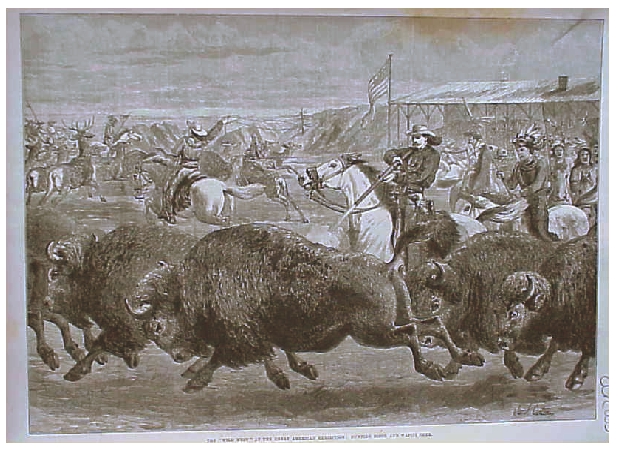
Buffalo Bill hunting Bison, Illustrated News of London,
1887Willian F. Cody (1846-1917) received the appellation "Buffalo
Bill" as a result of serving as a buffalo hunter for the Kansas-Pacific Railroad.
Buffalo hunters were employed to provide meat to the railroad workers. During the seventeen months
he was with the railroad, he killed 4,280 bison.
Born in Iowa, he moved with his family moved at an early age to Kansas. He father was absent from
home for long periods of time, partially due to the unpopularity of his political leanings. His
father was an abolitionist. Thus, like many boys of the age, Cody became self-supporting at
age ten, working for Russell, Majors and Waddell, at first on cattle drives supplying beef
to Albert Sidney Johnston who was then fighting the Mormon War. Later Cody worked as a freighter. Indeed, on one
of the trips, when Cody was only 11, he killed his first Indian.
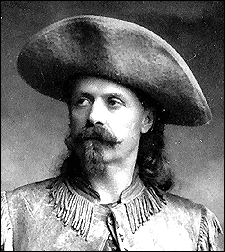
William F. Cody
Thus, Cody was an experienced rider at age 15 when he answered an advertisement
seeking riders for the newly created Pony Express. Cody was assigned to Slade's Division. The Division
the longest leg on the route, extending from Red Buttes Station to Rocky Ridge Station. When Cody's relief rider
was killed, Cody covered a distance of 322 miles in 21 hours, 40 minutes using 21 horses.
When the Pony Express was replaced by the telegraph, Cody became a civilian scout for the army and later, as
above noted, a buffalo hunter. As a scout, in 1872, he acted as a guide with John B. "Texas Jack" Omohundro
(see Rawlins II) for the
Grand Duke Alexis. In 1872, for his actions as a scout at the Battle of Summit Springs on the Platte River, Nebraska
[the battle was actually fought in Weld County, Colorado], Cody was awarded the
Medal of Honor. In the battle, July 11, 1869, Chief Tall Bull was killed and a white woman who had been captured by the Indians was rescued.
Some question exists as to who killed Tall Bull. Officially, Major Frank North is given
credit. Others, however, contend that Cody is to be credited.
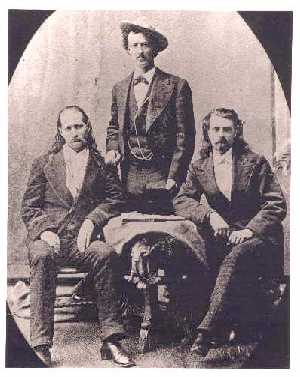 L. to R., Wild Bill Hickok, Texas Jack Omohundro, Buffalo Bill Cody
L. to R., Wild Bill Hickok, Texas Jack Omohundro, Buffalo Bill Cody
Cody's exploits came to the attention of Edward Z. C. "Ned Buntline" Judson (1821-1886), author of dime novels.
Buntline invited Cody to appear with Omohundro and James B. "Wild Bill"
Hickok in a touring stage "wild west show," Scouts of the Prairie. Notwithstanding that Cody was
not a good actor, his natural showmanship was popular with audiences. The show was
less popular with critics. Buntline claimed to have written the script in
four hours. Some critics wondered why it took so long. One critic for the Chicago Times wrote:
"Such a combination of incongruous drama, execrable acting, renowned performers,
mixed audience, intolerable stench, scalping, blood and thunder,
is not likely to be vouchsafed to a city a second time, even Chicago."
For more on Buntline, Cody, and Omohundro, see Rawlins.
Following Custer's
defeat at the Little Big Horn, Custer again returned west as a scout and earned the second
appellation of "Pahaska." Until 1906, Cody's Wild West Show would end with a
sanitized version of the battle.
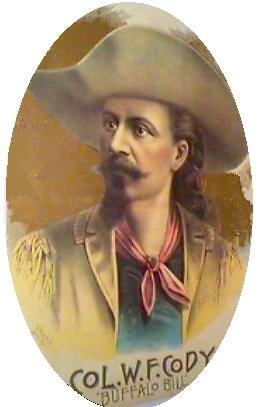
Buffalo Bill The title "Colonel," was not one
given by the Army, since he was a civilian, but was given by the Governor of
Nebraska.
The term "Pahaska," apparently derived from the Lakota
pahinhanska, meaning "long hair of the head," was
a name given Cody by Native Americans and popularized in Dime Novels.
As an example, the name was used by Col. Prentiss Ingraham, in his
account of the "Duel with Yellowhand"
in his 1882 "Penny Dreadful,"
Adventures of Buffalo Bill from Boyhood to Manhood, Deeds of Daring, Scenes of
Thrilling, Peril and Romantic Incidents in the Early Life of W. F. Cody, The
Monarch of Bordermen, published by Beadle's Boy's Library of Sport, Story and
Adventure.
Cody, of course, in his later Wild West Show, made the most of it. The Duel became
more and more elaborate, so that ultimately it appeared that Cody was fighting
all 500 Indians. An excerpt is printed below.
The Chapter begins with a description of General Merritt, on a forced march, near
present day Van Tassell, Wyoming. Cody is several miles ahead acting as a scout. Cody
observes two horsemen who are about to be attacked by the Indians:
Discovering the Indians, he at the same time beheld two horsemen whom he saw
to be whites, riding along unconscious of the presence of foes.
He knew that they must be scouts bearing
dispatches, and at once determined
to save them for they were riding in a direction down one valley that would
bring them directly upon the red-skins, who had already seen them, and had
sent a force of thirty warriors out to intercept them.
Instantly Buffalo Bill dashed over the ridge of the hill that concealed him
from the view of the Cheyennes, and rode directly toward the band going to
attack the two white horsemen.
They halted suddenly at sight of him, but, seeing that he was alone,
they started for him with wild yells.
But still he kept on directly toward them, until within range, when he
opened upon them with his matchless Evans rifle, a thirty-four-shot
repeater, and a hot fight began, for they returned the fire.
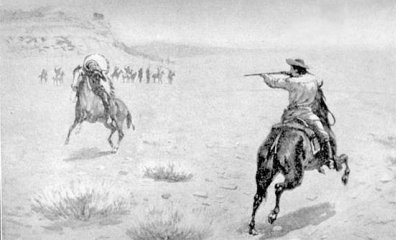 This was just what Buffalo Bill wanted, for the firing alarmed the horsemen
and placed them on their guard, and he knew that the Indian volleys would
be heard at the command and hasten them forward.
Having dropped a couple of red-skins and several ponies, Buffalo Bill
wheeled to the rightabout, dashed up to the top of a hill, and, signaling
to the two whites to follow him, headed for the command at full speed.
As he had anticipated,
the two men were scouts with important dispatches for General Merritt, and Bill's bold act had not only saved their lives, but also the dispatches, and the result of it was that the Fifth Cavalry went at once into line of battle, while the Cheyennes also formed for battle, though evidently surprised at being headed off at that point.
But they saw that they were double the force of the whites, and were
determined upon a fight, and their chiefs reconnoitered carefully
their foes' strength and position.
Buffalo Bill also volunteered to go out and get a closer look at them,
to see what they were up to, and General Merritt told him to do go,
but not to venture too near and expose himself.
This was just what Buffalo Bill wanted, for the firing alarmed the horsemen
and placed them on their guard, and he knew that the Indian volleys would
be heard at the command and hasten them forward.
Having dropped a couple of red-skins and several ponies, Buffalo Bill
wheeled to the rightabout, dashed up to the top of a hill, and, signaling
to the two whites to follow him, headed for the command at full speed.
As he had anticipated,
the two men were scouts with important dispatches for General Merritt, and Bill's bold act had not only saved their lives, but also the dispatches, and the result of it was that the Fifth Cavalry went at once into line of battle, while the Cheyennes also formed for battle, though evidently surprised at being headed off at that point.
But they saw that they were double the force of the whites, and were
determined upon a fight, and their chiefs reconnoitered carefully
their foes' strength and position.
Buffalo Bill also volunteered to go out and get a closer look at them,
to see what they were up to, and General Merritt told him to do go,
but not to venture too near and expose himself.
As he left the line two Indian horsemen also rode out from among
their comrades, and one was some lengths in front of the other.
At a glance Buffalo Bill saw that the two were full chiefs, and
they had not advanced far toward each other when he discovered that
he was the especial object of their attention.
But though one waited, the other came on, and the scout and the chief
came within a hundred yards of each other.
Then the Indian cried out in his own tongue:
"I know Pa-e-has-ka the Great White Hunter and want to fight him."
"Then come on, you red devil, and have it out," shouted back Buffalo Bill,
and forgetting General Merritt's orders not to expose himself, and to
the horror of the regiment, every man of whom saw him, as well as did the
Indians, he dashed at full speed toward the chief, who likewise, with a
wild yell rode toward him.
Together both fired, the chief with his rifle, and Buffalo Bill with his
revolver, and down dropped both horses.
Buffalo Bill nimbly caught on his feet, while the Indian was
pinned by one leg under his and with his war-cry the scout rushed
upon him.
As he advanced the chief succeeded in releasing his leg from beneath his
horse and again fired, as did Buffalo Bill, and both of them with revolvers.
The Indian's bullet cut a slight gash in Bill's arm, while he struck
the red-skin in the leg, and the next instant sprung upon him with his
knife, which both had drawn.
The hand-to-hand fight was hardly five seconds in duration, and Buffalo
Bill had driven his knife to the broad red breast, and then tore from
his head the scalp and feather war-bonnet, and waving it over his head,
shouted in ringing tones:
"Bravo! the first scalp to avenge Custer!"
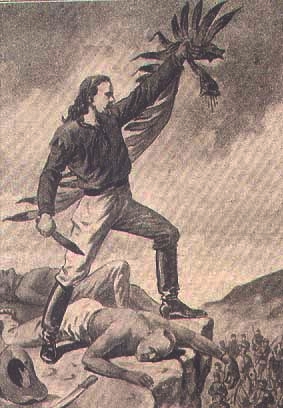 "First Scalp for Custer," image from 1903 brochure for Buffalo Bill's Wild West.
"First Scalp for Custer," image from 1903 brochure for Buffalo Bill's Wild West.
A shout of warning from the cavalry caused him to turn quickly and he
beheld the second chief riding down upon him at full speed.
But Bill turned upon him, and a shot from his revolver got him another
scalp.
But hardly had he stooped to tear it from the skull, when the Indians,
with wildest yells, charged upon him.
They were nearer to him than was the regiment, and it looked bad for
Buffalo Bill; but the gallant Fifth charged in splendid style, met the
Indians in a savage fight, and then began to drive them in wild confusion,
and pushed them back into the Agency a sorely whipped body of Cheyennes,
and grieving over heavy losses.
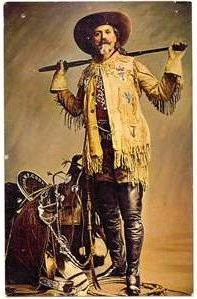 Upon reaching the Agency Buffalo Bill learned that the two Indians he
had killed in the duel were Yellow Hand and Red Knife, and Cut Nose, the
father of the former swore some day to have the scout's scalp.
But Buffalo Bill laughed lightly at this threat, evidently believing
the old adage that "A threatened man is long lived."
Upon reaching the Agency Buffalo Bill learned that the two Indians he
had killed in the duel were Yellow Hand and Red Knife, and Cut Nose, the
father of the former swore some day to have the scout's scalp.
But Buffalo Bill laughed lightly at this threat, evidently believing
the old adage that "A threatened man is long lived."
[Writer's note: Yellow Hand is more correctly known as Yellow Hair]
Later, in an early example of political correctness, some military officers contended
that Cody didn't really scalp Yellow Hand, he merely lifted up his hair. In contrast two observers on
the scene, including 5th Cavalry Scout Jules Green, attested to the taking of the scalp. Green also
observed
Cody wearing the scalp over his belt the next day while Cody was playing a game of
pool at the Red Cloud Agency. Indeed, shortly after the incident, Cody returned to
the stage in a touring production of The Red Right Hand or Buffalo Bill's First Scalp of Custer.
The final word, however, was a notice given by the Department of the Interior pursuant to the Native
American Graves Protection and Repatriation Act (NAGPRA), and 43 CFR 10.9,
in the Federal Register,
October 13, 2000, relating to the repatriation of human remains to the Cheyenne. The remains were
identified:
In 1876, human remains representing one individual were removed by
"Buffalo Bill" Cody during the Battle of Hat Creek, near present-day
Montrose, NE. In 1957, the grandchildren of Mr. Cody, Fred H. Garlow,
William Joseph Garlow, and Mrs. Jane Cody Garlow Mallehan, sold the
remains to the Buffalo Bill Historical Center. The remains, a scalp,
were identified by Mr. Cody as belonging to Yellow Hair, a Cheyenne
Indian. The remains are tied with two leather strips. No associated
funerary objects are present.
[Writer's note: It appears that the Federal Government still can't bring itself to
recognize Cody's title, colonel.]
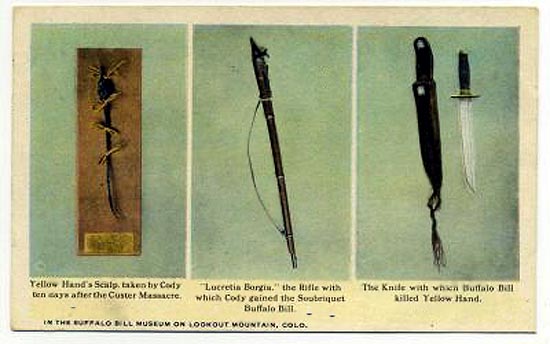
Postcard, Johnny Baker's Museum, Lookout Mountain, Colorado, 1923.
Next page, Buffalo Bill Continued, the Wild West Show.
|